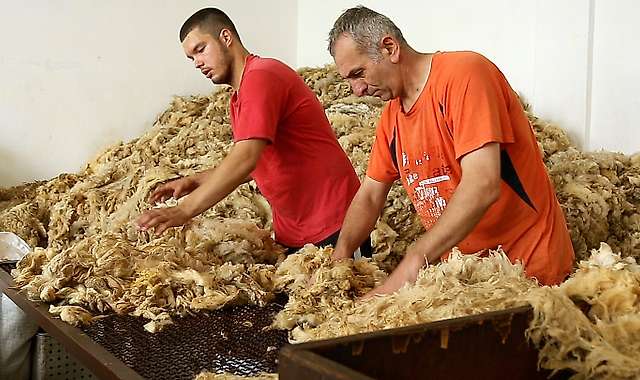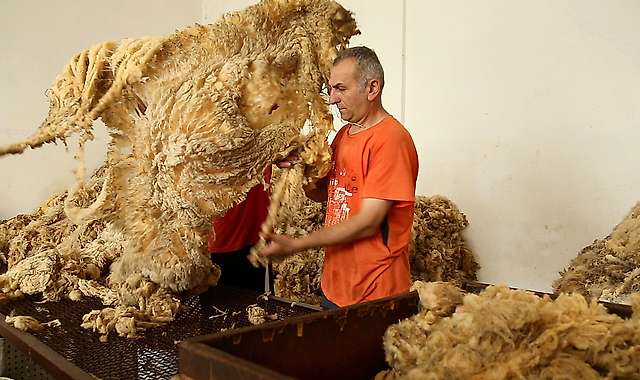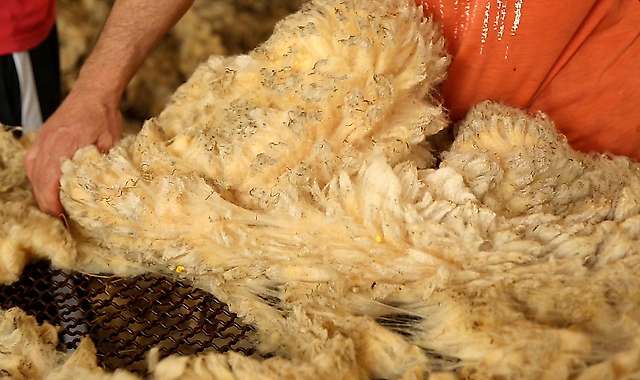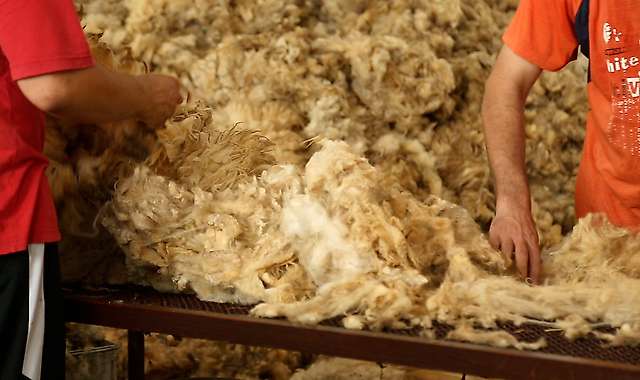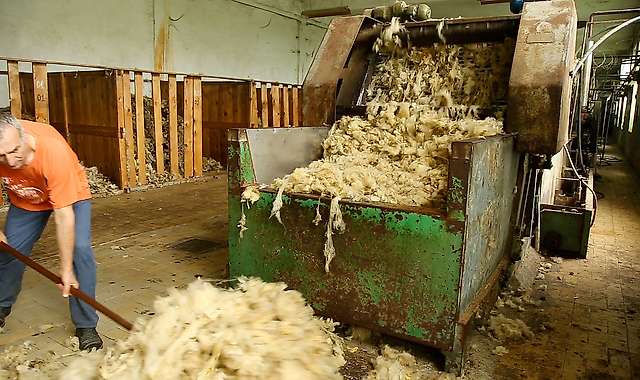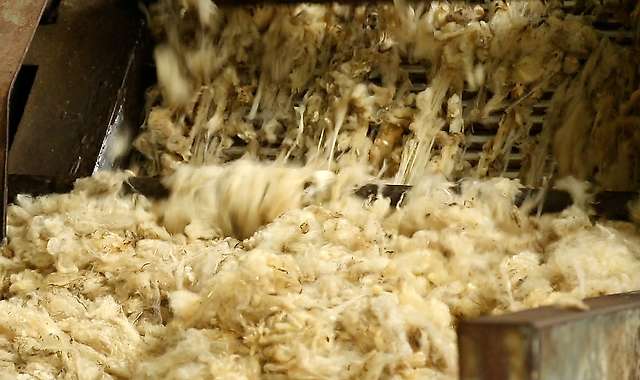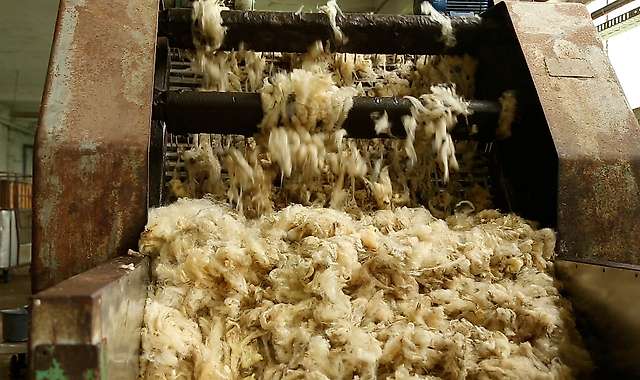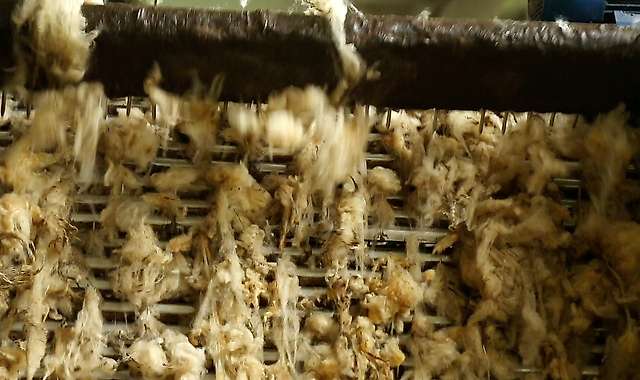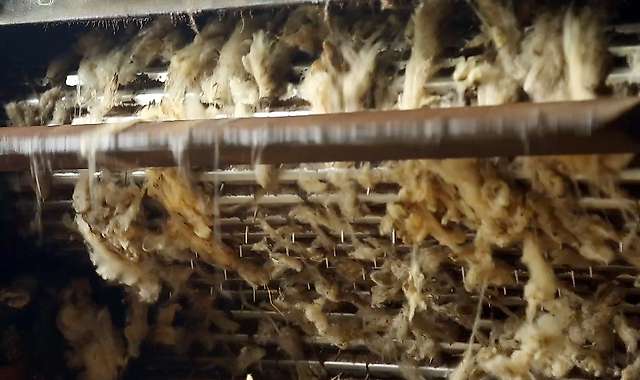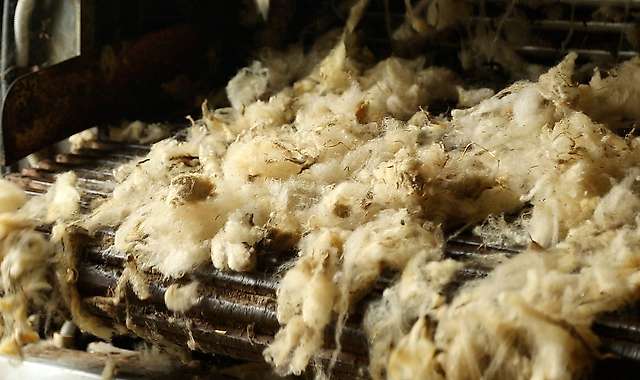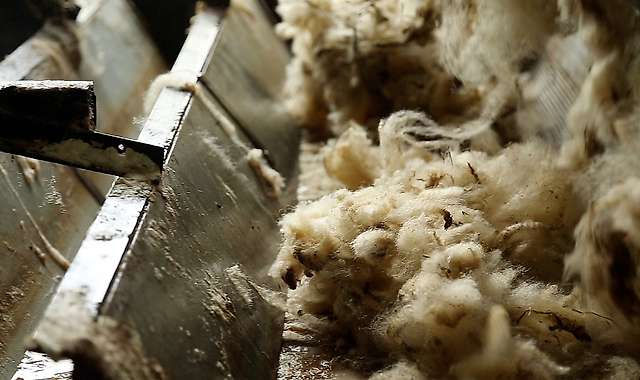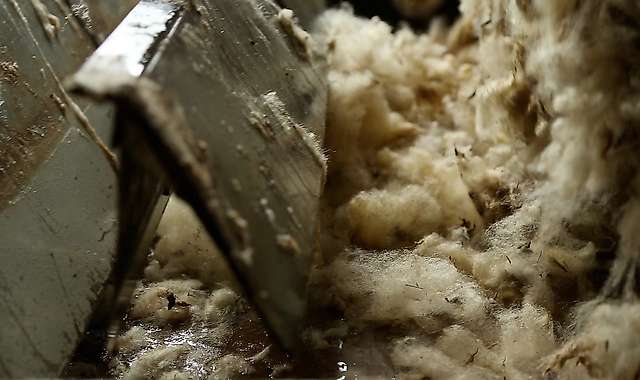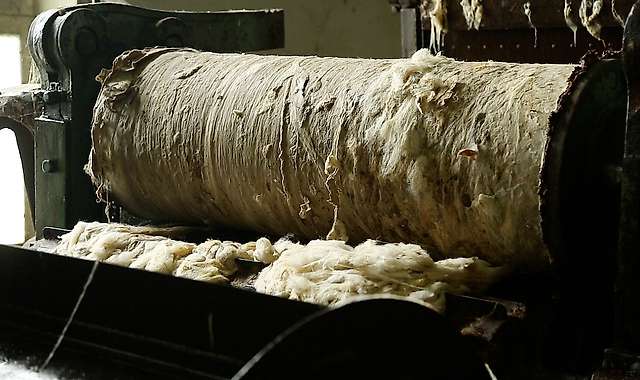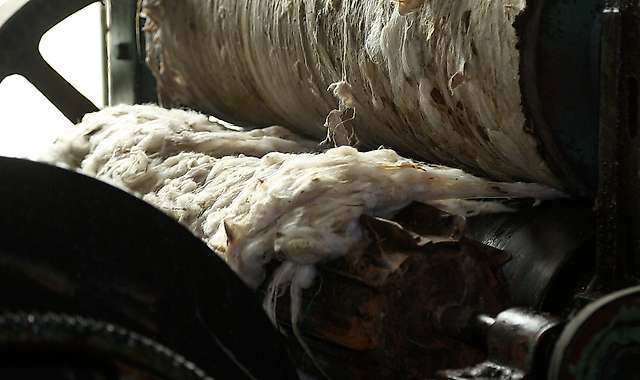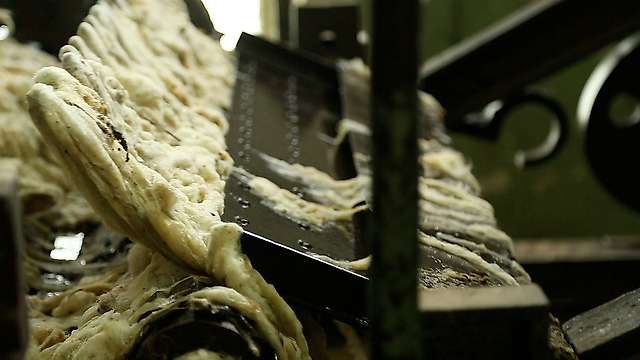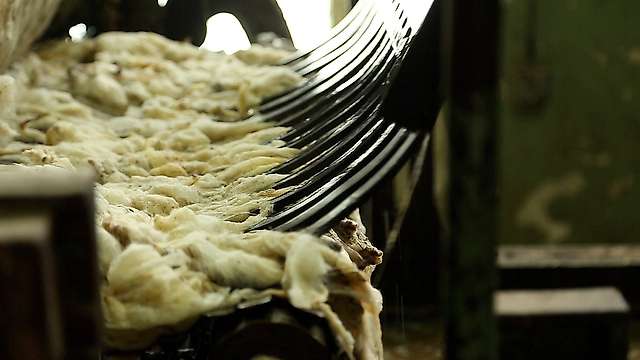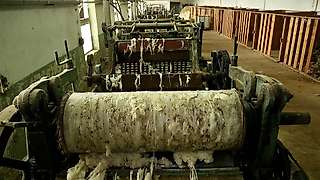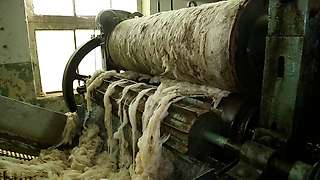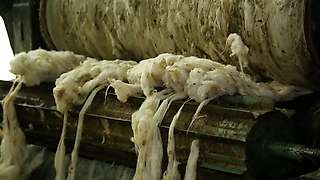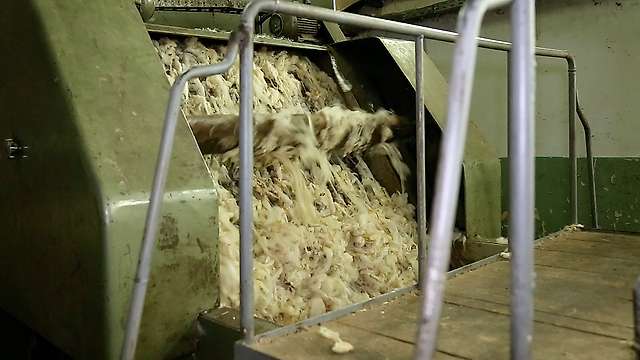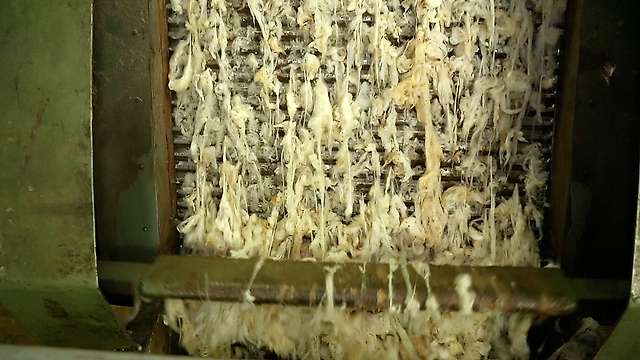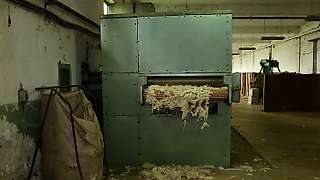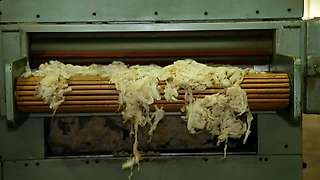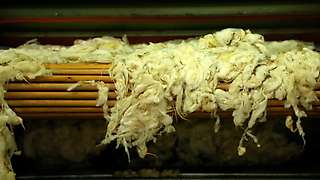In Revolana products, we use sheep wool from Serbia. This wool is collected from many small farmers in southern Serbia. Its scouring is done locally in Vučje near Leskovac. It is artisanal, on a small scale, with pure spring water with little limestone.
Step 1 – Sorting
Fleeces arriving for scouring are usually in one piece. It is the tangled hairs, the suint (natural greasy substance in sheep’s wool) and the impurities like bits of vegetables which make them holding in one piece.

Sorting consists of separating each fleece into areas of uniform quality, which differ according to the location on the animal. Wool of better quality is located on the shoulders and the flanks (in green on the picture below). This wool can be used for spinning or to produce woolen layers for quilts. Wool of lesser quality is located on the top of the legs and the back. It can be carded to produce felt or needle-punched wool. Finally, wool from legs, tail and bottom can only be used to produce carpets or insulation.

Several criteria are used to judge the quality of the wool fiber.
- The fineness of the fibers : the finesse depends on the breed of the sheep and, for the same sheep, of the area on the fleece. Sheep breeds we work with have a fiber thickness around 28 ~ 35 microns. The finer the wool, the softer it is.
- The length of the fibers : long fibers are the most qualitative and they will give the best result for spinning. Long fibers are more than 15cm while the short ones are less than 8cm.
- Resilience and elasticity : lower quality fibers break more easily and are less elastic. For quilts and pillows, elastic fibers are the ones that give the most volume.
- Wavy or curly (crimpiness) : wool fibers have many small zigzags. These ripples favor higher quality spinning and give wool more volume.
- Color : white wool is sought because it can be dyed. Wool of other natural colors has to be sorted well not to cause problems in a batch of white wool.
- No jar : jar is a thick hair that sometimes grows in the middle of the wool. Sheep are selected not to produce jar.
Sorting is hard work. Fleeces are greasy and may contain thorns or all sorts of pungent plant debris. Hands of workers must be hardened to no longer feel the bites.

Step 2 – Mechanical opening
Greasy wool contains all sorts of impurities like soil, vegetable fragments, wool wax, that can represent more than half the weight of the fleece. Several operations must be undertaken to be completely cleaned.
Wool wax is produced by the animal to protect it. It can be recovered during scouring and refined to produce the lanolin used in cosmetics.
Before scouring, wool goes into a mechanical machine called an opener. This operation is done with the dry wool. It enables dirt and dust to fall from the fibrous mass, and to deliver the wool in a more open form to the scouring bowls so that the hot water can penetrate more effectively. The opener includes a roller with many teeth with a thick rectangular tip that rotates at high speed. Unlike the weaver who is used before carding, the opener does not have sharp teeth to avoid tearing the wool fibers. The goal of the opener is really to break the fleece into smaller pieces that will be much easier to scour.
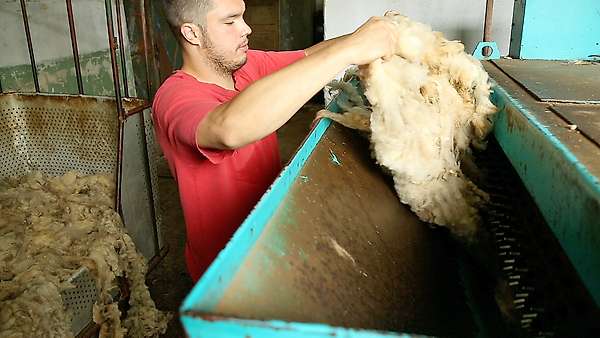



Step 3 – Scouring
Scouring is carried out by the continuous passage of the wool in 5 successive baths, heated to increase their emulsifying power, at a temperature above the melting point of the wool wax, around 60°C. The removal of the wool wax is done using sodium carbonate Na2CO3 and ecological soap at low concentration. Sodium carbonate is a sodium salt of carbonic acid that is not toxic to the environment. In common parlance, it is found in powder under the name of soda crystals or washing soda.
Importance of water purity
For the scouring of wool, it is essential to have water which, from the chemical point of view, is as pure as possible. Hard water (with limestone) cuts the soap, makes sticky lumps that attach to the wool fiber, are difficult to remove and cause many problems in the manufacturing operations down the line.
Our scouring facility uses water from the river Vučjanka which passes on the site and that is one of the least calcareous in Europe. The very low limestone concentration makes it possible not to treat it and to use soap at lower concentrations.


For the anecdote, upstream on the Vučjanka river, there is a small hydropower plant (MHE Vučje) which is the second oldest hydroelectric plant in Serbia. It was built in 1903 by Professor Djordje Stanojevic, a friend of Nikola Tesla. It was opened, symbolically, the same day in 1903 as the day of the liberation of Leskovac from the Turkish occupation in 1877. It is still active today with an installed capacity slightly higher than 1 MW. In 2005, it was included in the world heritage of technology, which includes only sixty objects.


The scouring machine
The scouring machine is a monster of solid metal from Belgium that dates from 1942. It still does a remarkable job. It includes a wool introduction system, a soaking tank, 5 successive scouring tanks and a drying system.


Water heating
The water used in scouring is heated with a wood boiler. This same boiler is used to heat the air in the drying block.

Treatment of used water
Before being returned to the river, used water passes through settling tanks. The mixture of grease and vegetable debris is collected in settling tanks for use in compost.
Introduction of the wool into the machine
Wool is manually introduced into the loader which drives it to the soaking tank. The loader consists of a carpet with claws and a system with two bars equipped with metal tips that regulates the amount of wool driven on the carpet.
Soaking
Wool goes first into a soaking tank. The purpose of soaking is to remove as much water-soluble impurities as possible.

The wool driven by the loader pours into the soaking tank.
Wool comes out of the soaking, is drained, then enters the first scouring tank.
Scouring tanks
Wool then goes through 5 successive scouring tanks. Long metal claws brew the wool in each tank and push it to the exit where a roller pulls it to the next tank. Wool is wrung at the exit of each tank. Each tank contains a solution of pure water with added sodium carbonate or soap. We have the following concentrations:
- Tank 1 – sodium carbonate Na2CO3 0,1% intended to open wool fibers and to remove wool wax and suint.
- Tank 2 – soap 0,025% : scouring.
- Tank 3 – soap 0,05% : scouring.
- Tank 4 – Eau pure : rinsing.
- Tank 5 – Pure water : rinsing.
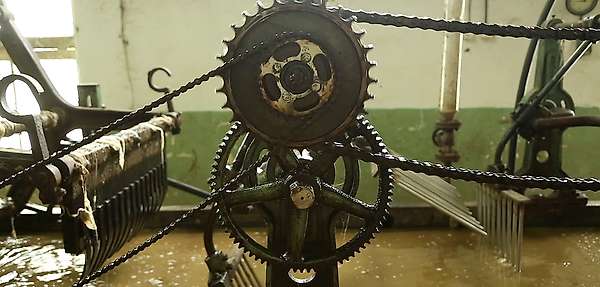
At the outlet of the scouring tank, wool is gently deposited at the inlet of the wringing roller with a claw shovel.
Exit of the scouring
At the end of the scouring, wool is squeezed between two rolls one last time before to arrive at the entrance of the drying block.
Drying
Wool is fed into the drying block with a loader similar to that of the machine inlet. The loader regulates the amount of wool that arrives in the drying block.
The drying block is an oversized hot air blower that removes most of the moisture from the wool.
Exit of the washed and dried wool from the drying block
The simple comparison of the greasy wool fleeces from which we started, to the wool resulting from the scouring process makes it easy to realize the scale of the transformation.

Next step: carding
At the end of the scouring process, wool is finally packaged in bales to be delivered to the users. It is ready to be carded to make yarn or woolen waddings. This step will be the subject of a future article.



